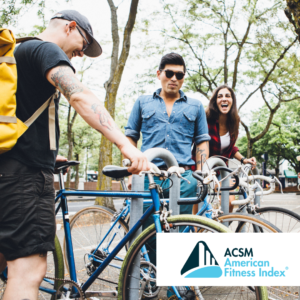
Without question, activity friendly spaces—those that support walking and bicycling for leisure and transportation—are good for both personal health and the environment. When trips that are usually taken via automobile are taken by foot or bike instead, there is reduced traffic, congestion and pollution. But are these spaces good for businesses? You can bet your bottom dollar they are.
Research supports the idea that activity friendly spaces can drive economics and spending. Several studies have noted that customers who arrive via bike tend to frequent commercial areas more often than customers who arrive via other modes, and they often spend more, resulting in higher sales.1-5 In New York City, the installation of a bike lane increased the likelihood of travel for both pedestrians and cyclists, creating greater exposure to businesses in the area studied4 and contributed to an increase in retail sales and fewer commercial vacancies in the neighborhood.6 A survey of San Francisco retailers revealed that the majority (65%) perceived that bike lanes had a positive impact on their sales and noted few negatives.7 Communities designed to promote active living (i.e. provisions for pedestrians and cyclists, greenspace, trails) also are noted to have greater property values and result in greater revenue from property taxes than communities that do not include these features.8 Areas with greater walkability and active living supports are tied to the benefits of decreased pollution, improved social capital, more community activism and less car use, which was related with improved office, retail and apartment values.9
Promoting walking or bicycling to work offers significant benefits to employers; the many health benefits associated with biking and regular exercise include decreased healthcare costs, improved productivity, reduced absenteeism and aligns with the goals of most worksite wellness programs.10 The League of American Bicyclists, as a part of their Bicycle Friendly AmericaTM11 program, has a Bicycle Friendly BusinessTM initiative which allows businesses to apply to be recognized as bicycle friendly at different levels (bronze, silver, gold or platinum). League-recognized Bicycle Friendly Businesses have noted a wide range of motivation for promoting cycling among their employees and customers (e.g. economic outcomes, reduced healthcare costs, sustainability goals12 ). They have also noted the importance of serving as a good example for their community and that cycling represents a core part of their company’s identity.
Other strategies that local businesses can employ to promote active transportation can include participation in advocacy for infrastructure that encourages walking and biking. Partnering with local pedestrian and cyclist coalitions or advocacy groups to support policies, legislation or funding for capital improvements to local spaces can be helpful, as buy-in from additional stakeholders bolsters confidence in those policies. For example, advocating for greater bicycle parking may result in some controversy if it is accompanied by the elimination of car parking spots. However, initiatives to replace on-street parking in commercial districts with a bike corral typically yields spots for 8-10 bikes where one car could have parked. It has been well documented that this swap typically does not harm sales, rather, it can lead to an increase in revenue.13 After seeing the impact in other areas, merchants in Portland, OR, indicated their overwhelming support for the swap to improve business and enhance the overall streetscape.14 Additionally, increased spending in a commercial area could generate greater sales tax for the region, helping the community to pay for the installation and upkeep of the supportive infrastructure, possibly leading to expanded efforts.
Businesses have an important role to play in cultivating activity-friendly spaces as key stakeholders in local economies. The potential for impact beyond commercial benefit is substantial, influencing health and environmental outcomes throughout the community where they live and work. Investments in cycling and pedestrian infrastructure just make good “cents” for businesses.
Author: Melissa Bopp, Ph.D., FACSM
References
- Popovich N, Handy SL. Bicyclists as Consumers. Mode Choice and Spending Behavior in Downtown Davis, California. Transportation Research Record. 2014;2468:47-54.
- Clifton KJ, Muhs C, Morrissey S, Morriss T, Currans K, Ritter C. Consumer Behavior and Travel Mode Choices. Portland, OR: Oregon Transportation Research and Education Consortium (OTREC); 2012.
- Bent E, Singa K. Modal Choices and Spending Patterns of Travelers to Downtown San Francisco, California: Impacts on of Congestion Pricing on Retail Trade. Transportation Research Record: Journal of the Transportation Research Board. 2009;2115:66-74.
- Bernier-Heroux L, Ryan J. East Village Shoppers Study: A Snapshot of Travel and Spending Patterns of Residents and Visitors in the East Village. 2012; https://www.transalt.org/cdn/farfuture/9efumRfRqlXm_tZbqTYHclU2lQLb2uDlCiQiGakdKms/mtime:1472894797/sites/default/files/news/reports/2012/EV_Shopper_Study.pdf. Accessed November 16, 2016.
- Rowe K. Bikenomics: Measuring the Economic Impact of Bicycle Facilities on Neighborhood Business Districts. Seattle, WA: University of Washington College of Built Environments; 2013.
- Arancibia D. Cyclists, Bike Lanes and On-Street Parking: Economic Impacts. Toronto, ON: Toronto Cycling; 2013.
- Drennan E. Economic Effects of Traffic Calming on Urban Small Businesses. 2003; http://www.sfbike.org/download/bikeplan/bikelanes.pdf. Accessed November 17, 2016.
- Active Living Research. The Economic Benefits of Open Space, Recreation Facilities and Walkable Community Design. San Diego: Robert Wood Johnson Foundation; 2010.
- Pivo G, Fisher JD. The Walkability Premium in Commercial Real Estate Investments. Real Estate Economics. 2011;39(2):185-219.
- Tran M, Forst L, Buchanan S. Not on the Radar: Active Commuting as a Workplace Wellness Issue. Journal of Occupational and Environmental Medicine. Sep 2015;57(9):E91-E92.
- League of American Bicyclists. Building A Bicycle Friendly America. Washington DC: League of American Bicyclists; 2013.
- Vairo N, Bopp M, Sims D. Best practices for businesses promoting bicycling. International Journal of Health Promotion and Education. 2017/11/02 2017;55(5-6):298-310.
- Lee A, March A. Recognising the Economic Role of Bikes; Sharing Parking in Lygon Street, Carlton. Australian Planner. 2010;47(2):85-93.
- Meisel D. Bike Corrals: Local Business Impacts, Benefits, and Attitudes. Portland, OR: Portland State University School of Urban Studies and Planning; 2010.


